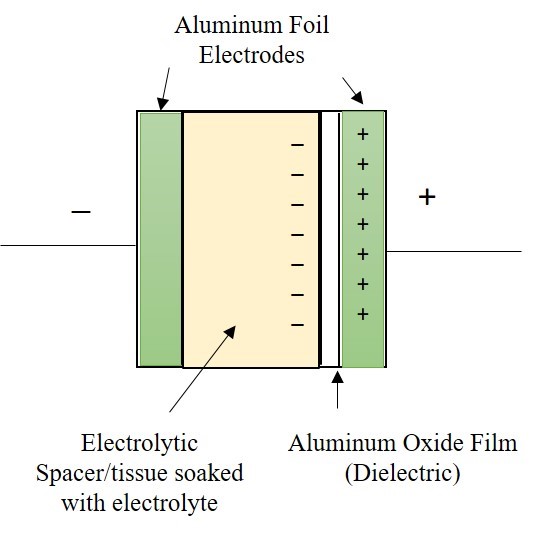An electrolytic capacitor is a type of capacitor that uses an electrolyte solution as one of its plates. The electrolyte solution is placed between the anode and cathode layers and serves as a dielectric material.
Electrolytic capacitors are polarized capacitors, which means they have a positive and negative terminal. The anode (positive) is typically made of a thin layer of aluminum foil, while the cathode (negative) is made of a metal oxide layer that is formed on the surface of the anode through a process called anodization.
Features of Electrolytic Capacitor
- High capacitance for their physical size
- Relatively low cost
- Polarized design with positive and negative terminals
- Limited lifespan, typically between 1000 and 5000 hours
- Sensitivity to temperature and voltage
- Available in both radial and axial lead packages
Symbol of Electrolytic Capacitor:

Working of Electrolytic Capacitor:
When a voltage is applied to the anode of an electrolytic capacitor, electrons flow through the circuit and accumulate on the surface of the anode. As more electrons accumulate, the electric field between the anode and cathode increases, causing the electrolyte solution to become polarized.
The dielectric strength of the electrolyte solution is much lower than that of a typical dielectric material such as air or plastic, which means that a large electric field can be sustained across the capacitor. This allows the capacitor to store a large amount of energy in a relatively small physical size.

Types of Electrolytic Capacitor:
There are two main types of electrolytic capacitors:
- Aluminum electrolytic capacitors
- Tantalum electrolytic capacitors
Aluminium Electrolytic Capacitors:
Aluminum electrolytic capacitors are the most common type and are widely used in many applications. They have a large capacitance range and are available in both radial and axial lead packages. They also have a relatively low ESR (equivalent series resistance), which makes them ideal for filtering applications.
Tantalum Electrolytic Capacitors:
Tantalum electrolytic capacitors are less common but have some unique features that make them ideal for certain applications. They have a higher voltage rating than aluminum electrolytic capacitors and are more stable over a wider temperature range. They are also physically smaller than aluminum electrolytic capacitors with similar capacitance values.
Applications of Electrolytic Capacitor:
Electrolytic capacitors are used in many electronic circuits for a variety of purposes. Some common applications such as:
- Power supply filtering: Electrolytic capacitors are often used in power supply circuits to filter out unwanted noise and ripple.
- Audio circuits: Electrolytic capacitors are used in audio circuits for coupling, decoupling, and filtering applications.
- Motor control: Electrolytic capacitors are used in motor control circuits to reduce electromagnetic interference (EMI) and protect the circuit from voltage spikes.
- Lighting: Electrolytic capacitors are used in lighting circuits to stabilize the voltage and reduce flicker.

